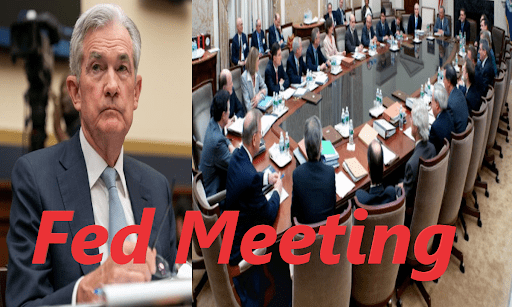On Wednesday afternoon. Fed meeting Reserve Chair Fed Meeting, For the first time since the financial crisis. The central bank is prepared to lower interest rates. These are some things to keep an eye on. Jerome H. Powell will have the opportunity to explain the interest rate decision.
The fed meeting Reserve is widely anticipated to drop interest rates when its meeting concludes on Wednesday. The first fall since authorities slashed them to near zero during the depths of the financial crisis in 2008.
It’s a watershed moment and one that should be taken seriously. Uncertainty fueled by President Trump’s trade war and slowing global growth threatens the economy’s prospects. despite a robust domestic labor market and consumer spending.
The fed meeting is trying to ward against a downturn at a time when inflation is low and interest rates remain historically low. Leaving the central bank with few tools to support the economy if it enters a slump.
After the release of the decision at 2 p.m. Fed meeting Chair Jerome H. Powell will hold a press conference at 2:30 p.m. To explain the decision and provide direction on what comes next. Here’s what to look out for.
Dimensions and Scope Fed Meeting
Most investors anticipate a quarter-point rate drop at this meeting. But, administrators may choose to do something more dramatic: In 2007. For example, the fed meeting cut rates by half a point in order to. Stay ahead of a weakening economy.
Most economic indices were stable at the time. But financial conditions were tightening and the housing market had slowed significantly. This time, the Fed’s signals that one or more rate cuts are on. The way has been sufficient to keep credit readily accessible.
Half-point cuts are suitable “when speed is of the essence. Like as in financial crises or if you’re behind the curve on economic data.” According to Michael Feroli, J.P. Morgan’s top US economist. “None of those two circumstances appear to exist right now.”
When investors misinterpreted a statement by John C. Williams, president of the Federal Reserve Bank of New York. As a signal that the fed meeting may drop interest rates by a half point. His bank took the extraordinary step of emphasizing that his remarks were not intended as a policy signal. Many Fed watchers interpret the opposition as a sign that the July move would be minor.
But that raises another question: Would the fed meeting lower interest rates again this year? Markets believe so.
What is the Fed Meeting concerned about?
Mr. Powell will have an opportunity to explain why a cut is being considered, and his remarks will help give insight on whether it will stand alone or whether the fed meeting is concerned enough to consider more steps in the future.
It’s possible that the fed meeting was scared in late May and early June, when Mr. Trump threatened to put tariffs on Mexico over immigration difficulties, causing markets to sway and job increases to halt. Officials laid the groundwork for a future cut during their June policy meeting, and now they may have to follow through, despite the fact that trade tensions have eased somewhat, stock indexes are once again tracing record highs, and the labour market added an impressive 224,000 positions last month. If the rate decrease in July is simply a confirmation of earlier message, it is unclear if there will be another.
Instead, the Fed may be immunising the economy against threats it perceives to be real and ongoing, based on the slowing of global manufacturing, low inflation, and evidence of bond market trepidation. If those forward-looking signs guide policymakers, another reduction may appear appropriate — even if most domestic economic indicators remain stable. Mr. Powell may avoid answering the issue of what happens next, giving himself and the committee more leeway.
Fed Meeting What about Donald Trump?
Based on his comments this week, the president has been pressuring the fed meeting to lower interest rates, and he is unlikely to be satisfied with a minor adjustment. On Tuesday, Mr. Trump said he wanted a “large” cut and accused the Fed of suffocating the economy with its rate hikes in 2018.
Mr. Trump does not have control over the independent central bank, but by breaking with tradition and calling for action, the White House has created an optics problem for the Fed. Even if officials lower rates for strictly technical reasons, some observers may assume they bowed to pressure. The fed meeting values its independence from politics because monetary policy functions best when its stewards are free to make decisions that will benefit the economy.
Throughout the sentence, there are signals.
A few significant sentences in the Fed’s post-meeting statement are worth keeping an eye on. While the Fed will not issue new economic estimates until its September meeting, how it portrays the economy will reveal how the complete committee perceives the current situation.
Mr. Powell may be their leader, but all five fed meeting governors and five of the 12 regional presidents have equal monetary policy votes, so the diversity of viewpoints is important.
Officials indicated in their most recent statement that while growth was projected to continue, “uncertainties regarding this forecast have intensified.” Given the “uncertainties and reduced inflation pressures,” the committee will “closely examine the implications of new information for the economic outlook and will respond as necessary.” Those were hints that a cut was on the way. If central bankers wish to send a message about the future, they may either restate or abandon such positions.
It’s also critical to keep an eye out for disagreeing votes. Eric Rosengren, president of the Federal Reserve Bank of Boston, may vote against lowering interest rates. That would be Mr. Powell’s second no vote, and the first in support of higher interest rates. Several Fed observers believe that Esther George, head of the Kansas City Fed, may also dissent in support of keeping rates constant.
Lastly, the fed meeting might use its announcement to unveil a new strategy for dealing with its large bond holdings. Officials have begun reducing the size of the Fed’s balance sheet, which swelled as the Fed purchased government-backed assets to help the economy during and after the recession. This unwinding, which is likely slowing the economy slightly by raising interest rates, is set to conclude in September. It’s possible that policymakers would halt the process early so that their strategy is universally aimed at boosting GDP.
Such pesky costs
If you’re searching for a subtle signal about whether another cut is on the way, watch if policymakers focus on America’s inflation gap in their statement or whether Mr. Powell does at his press conference. Authorities have grown increasingly concerned about persistently low price increases, and while Mr. Powell has stated that he expects inflation to eventually climb, progress has been slow.
The Fed formally announced a 2% target in 2012 but has yet to meet it consistently. In the year to June, the central bank’s favored inflation indicator gained only 1.6 percent. The president of the Federal Reserve Bank of Chicago, Charles L. Evans, stated on July 16 that he would be fine with a “two” of rate decreases this year “on balance.”
If you’re searching for a subtle indication about whether another rate drop is on the way, pay attention to whether policymakers focus on America’s inflation gap in their statement or whether Mr. Powell does during his press conference. Authorities have become more concerned about persistently low price increases, and while Mr. Powell has stated that inflation will eventually rise, progress has been slow.
The fed meeting formally established a 2% target in 2012 but has yet to accomplish it stably. In the year to June, the central bank’s preferred inflation index climbed by only 1.6 percent. On July 16, Federal Reserve Bank of Chicago President Charles L. Evans stated that he would be fine with a “two” of rate decreases this year “on balance.”






